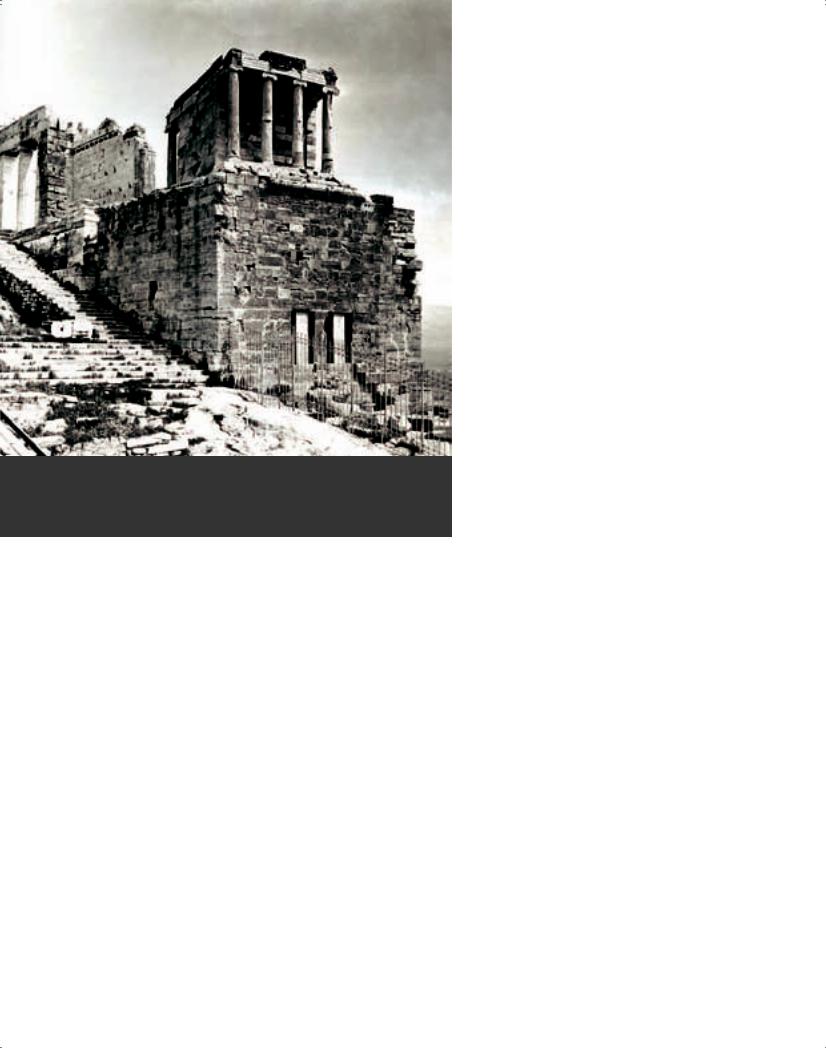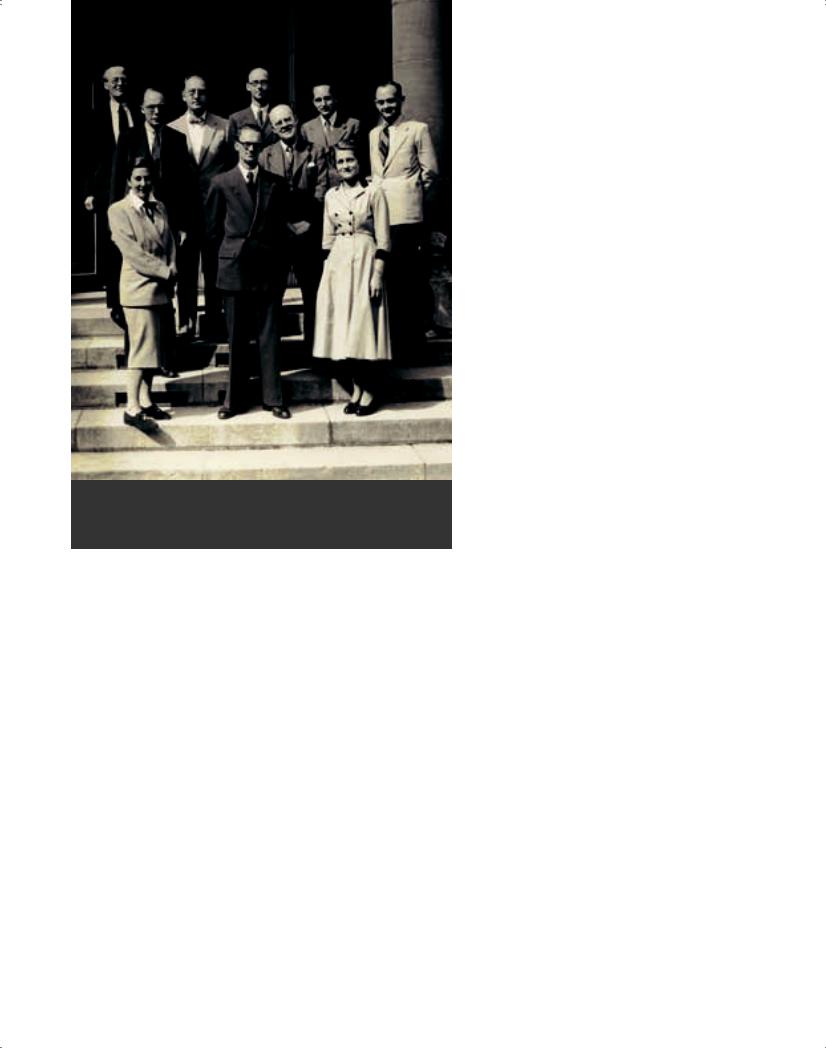
ICCROM_ICS11_History_en
.pdf
xx |
ICCROM and the Conservation of Cultural Heritage. A history of the Organization’s first 50 years, 1959-2009 |
|
|

1
The context for creation of an International Conservation Centre
The first article of the Statutes of ICCROM states the purpose of the organization as follows:
“The ‘International Centre for the Study of the Preservation and Restoration of Cultural Property’, hereinafter called ‘ICCROM’, shall contribute to the worldwide conservation and restoration of cultural property by initiating, developing, promoting and facilitating conditions for such conservation and restoration.”2
In 2010, after some fifty years of activity, ICCROM continues to operate as a small-sized but efficient intergovernmental organization in the ‘family’ of UNESCO. Nearly 130 States have become members of the organization. It was created in the aftermath of the Second World War by decision of the General Conference of UNESCO in New Delhi in 1956. Subsequently, an agreement was signed with the Italian Government, who invited the new organization to be established in Rome, already the headquarters of the renowned Italian Central Institute of Restoration (Istituto Centrale del Restauro, ICR; now the Istituto Superiore per la Conservazione e il Restauro). Hence its first abbreviated name: The Rome Centre. In 1971, this short version of its full title was changed to International Centre for Conservation, and in 1977 was changed again to ICCROM. After the first five States had adhered, a Provisional Council was appointed in 1958, which in turn appointed the first Director, Harold James Plenderleith (1898-1997), the distinguished former Director
of Research at the British Museum Laboratory. Plenderleith attended the meeting of the Provisional Council in December 1958, in his capacity of Director of the Centre, and formally took up his post in Rome from 1 March 1959, when the Centre was considered to have become operational.3
The creation of ICCROM did not happen in a void. Rather, it was part of a certain cultural continuity, which had emerged due to the efforts of individuals and institutions, and which had gradually gained momentum. Within the more general history of the conservation of cultural heritage, the Second World War undoubtedly represented a watershed, raising heritage awareness definitively to international consciousness. Together with the loss of millions of lives and the immense destruction of property all over the world, there was also vast destruction of works of art, ancient monuments, and historic towns and villages. As a result, people became painfully aware of the values and cultural and social identity associated with destroyed places and objects. In many countries, it was taken as a major objective in the aftermath of the war to pay particular attention to damaged works of art and architecture. This resulted in new norms and legislation at the national and local levels, as well as renewed efforts at the international level to respond to emerging needs, to share acquired knowledge through conferences and training programmes, to agree on universally valid principles for safeguarding, and to designate special funds for restoration and reconstruction of monuments and heritage sites.
1 The context for creation of an International Conservation Centre |
1 |
|
|

The historical context
While the Second World War (1939-1945) did produce a new situation with problems on a scale vaster than ever before, the roots of the policies went back to decades and even centuries earlier. The processes of national thought in various countries, particularly in Western and Southern Europe, had already resulted in efforts of an international scale in the 18th century. The idea of a common heritage of humanity was recognized by many travellers, who undertook a ‘grand tour’ to countries with a classical inheritance, first to Italy, later to Greece, the Near East, and further. At the same time, the Swiss jurist and philosopher, Emmerich de Vattel (1714-1767) touched upon the question of works of art being part of the common heritage of humanity in his The Law of Nations (Le droit des gens; ou Principes de la loi naturelle, appliques à la conduite et aux affaires des nations et des souverains, 1758).4
Drawing upon earlier philosophical thought, writers of the 18th century came up with some landmark concepts related to heritage and history. The contribution to modern philosophical thought of the Age of Reason through the work of thinkers such as Immanuel Kant is fully recognized. Continuing the work of earlier historiographers and responding to the exploratory spirit of the time, the foundations of modern historical consciousness were clarified particularly by the Neapolitan lawyer Giambattista Vico (1668-1744) and the German historiographer Johann Gottfried Herder (1744-1803),5 who reflected on the meaning of truth in specific historical and cultural contexts, and consequently the significance of heritage in response to cultural diversity.
The period from the end of the 18th throughout the 19th century became crucial for the further development of conservation concepts and principles. While causing much destruction of historic buildings and archives in France, the French Revolution of 1789 was yet another key period for deepening the awareness of heritage and challenging its protection. In particular, in this period, people stressed the significance of heritage to the nation, i.e. the importance of national monuments. There were several orders for the protection of such heritage, ordering prison terms for whoever damaged or destroyed des monuments de sciences et d’arts.6 We can also remember the letters by Antoine Quatremère de Quincy (1755-1849), who objected to the decision by Napoléon Bonaparte to remove important works of art from Italy to collections in Paris, stressing the importance of keeping them in situ.7
The early 19th century was marked by a Romanticism inspired also by the rediscovery of the classical
heritage in the southern Mediterranean countries. Its proponents noted that building technology was still based on the principles consolidated in technical manuals published since the 16th century, which had facilitated the transmission of know-how and skills. Consequently, professionals in several countries, beginning with England, Germany and France in particular, were involved in the restoration of historic buildings, especially ancient churches and palaces. The most renowned amongst them were Sir George
Gilbert Scott in |
England, Karl Friedrich Schinkel |
in Prussia, and |
Eugène Emmanuel Viollet-le-Duc |
in France. Their aim was to restore and sometimes reconstruct the ancient image of historic buildings, while at the same time making them available for contemporary users. Such ‘stylistic or historicizing restoration’ contributed to increased knowledge about the history of art and architecture, and became part of the more general fashion of historicism and the revival of historic styles in contemporary architecture.
The 19th-century ‘restoration fury’ did not pass without criticism. Indeed, the critics gradually became so powerful as to overrule restorers altogether. John Ruskin and William Morris, the foremost critics and protagonists of the ‘conservation movement’, considered ‘restoration’ a crime and favoured policies of maintenance and conservation. This critical attitude stressed the issue of cultural diversity and the recognition of historical time as expressed, for example, in material authenticity and the patina of age. While in English usage the words ‘conservation’ and ‘preservation’ thus became dominant, Latin languages have continued to use the word ‘restoration’ based on meanings that it had acquired through history. As a result, reflecting these different attitudes, ICCROM’s full official name (dating from its creation in 1956) includes both concepts: preservation and restoration. The distinction between the Anglo-Saxon and Latin languages is also reflected in cultural terms. Obviously, the differences between cultures do not stop here, and one of the tasks of ICCROM, particularly in its training programmes, has always been to look for methodologies that bridge such differences and to find common denominators, without forcing unfamiliar concepts on local cultural traditions.
From the late 19th to the early 20th century, the modern recognition and protection of cultural heritage has encompassed all regions of the world including Europe, America, Asia and Africa. It is recognized that the earlier traditional continuity was in itself a form of conservation. In reality, many non-European countries, including India and China, had established their own traditional conservation practices and guidelines.8 Unfortunately, colonization,
2 |
ICCROM and the Conservation of Cultural Heritage. A history of the Organization’s first 50 years, 1959-2009 |
|
|

industrialization and globalization have represented forces that have tended to discontinue such traditions. The introduction of modern principles of conservation has often been based on the recognition of the inevitable interruption of traditions, and proposes to identify and retain the documentary evidence of earlier achievements that are still present in the form of physical remains, i.e. the ‘monuments’ that carried messages from past generations.
The modern principles are reflected in international doctrine as well as in most national legal acts. Conservation and restoration efforts are principally based on a historical consciousness and the consequent recognition of heritage. Early historiography, in fact, has had somewhat parallel developments in different parts of the world, including the Middle East, China, and Europe. Consequently, there are early examples of protection regulations in several countries, but the formal recognition and protection of cultural heritage generally dates from the late nineteenth or the early twentieth century. More recently, sensitivity towards living traditional cultures has added new hope to keeping such traditions alive, one promoted even through international instruments, and has introduced parallel efforts that have rapidly been taken up in all parts of the world. The integration of the different aspects of recognition of cultural heritage, whether physical, intangible, or living, and the motivation and involvement of society in its safeguarding, is one of the challenges of the 21st century.
Early international conservation initiatives
The League of Nations
The Hague Convention adopted by UNESCO in 1954 was in fact the fifth version of that agreement, starting with the first proposal by the Russian Emperor Alexander II (A Project of an International Declaration Concerning the Laws and Customs of War) which was adopted by an international conference in Brussels in 1874. It declared that culture was a common heritage of humanity and cultural property was considered irreplaceable once destroyed. Indeed, the question of recognizing cultural heritage as a common heritage of humanity is a fundamental precondition for any international activity. At the same time, the recognition of universality must necessarily sustain the specificity of and the particular identity associated with a work of art or historic object in its cultural-historical context. Such recognition must be based on research and scientifically and culturally
reliable information (eventually to be reflected in the first of ICCROM’s statutory tasks: “collect, study and circulate information concerned with scientific, technical and ethical issues relating to the conservation and restoration of cultural property”).
The First World War (1914-1918) was another tragic period which, however, had some valuable consequences, resulting in the establishment of an international system to set up links and to join forces for the common good. The League of Nations (1919-1946), predecessor of the United Nations Organization, was established in 1919. The tasks of this organization included the reinforcement of relationships between States. From 1920 it considered establishing a technical body to this end and, as a result, in 1922 it founded the International Committee on Intellectual Cooperation. This involved some twelve major intellectuals of the time, including Henri Bergson, Albert Einstein, Marie Curie, Béla Bartók, Thomas Mann, and Paul Valéry. It formed special Committees of Experts as needed, that included the International Commission on Historical Monuments, the Committee of Scientific Advisors, and the Committee of Architectural Experts. The Committee set up the International Institute of Intellectual Cooperation as its executive organ in Paris in 1924 (starting work in 1926) in order to carry out the decisions of the Committee.9 These organizations were to be the predecessors of UNESCO, established after the Second World War, on 16 November 1945, as a specialized agency of the newly created United Nations Organization.10
International Museums Office (IMO)
Another NGO, created by the International Committee on Intellectual Cooperation, was the International Museums Office (IMO, 1922-1946), which initiated a number of studies and publications on the conservation of objects and collections. It was the direct predecessor of ICOM, the International Council of Museums, which was established after the Second World War in 1946. From 1927 the International Museums Office published an important periodical, Mouseion, which dealt particularly with history museums. UNESCO later, from 1948, took over the concept of the periodical and enlarged it to cover all kinds of museum, naming it Museum. The IMO organized two important international scientific conferences, one in Rome in 1930, the other in Athens in 1931, the papers of which were published in Mouseion. The topic of the Rome conference was the study of scientific methods for the examination and preservation of works of art, and that of the Athens conference the conservation of architectural monuments.
1 The context for creation of an International Conservation Centre |
3 |
|
|

It is the Athens conference that is still referred to because of its Conclusions regarding the conservation of historic monuments. It was the first of its kind and the only one to be brought to the attention of the League of Nations. The conclusions were based on principles that gave preference to ‘conservation’ over ‘restoration’ 11:
•“Whatever may be the variety of concrete cases, each of which are open to a different solution, the Conference noted that there predominates in the different countries represented a general tendency to abandon restorations in toto and to avoid the attendant dangers by initiating a system of regular and permanent maintenance calculated to ensure the preservation of the buildings.
•Consequently, while approving the general tendency of these measures, the Conference is of opinion that they should be in keeping with local circumstances and with the trend of public opinion so that the least possible opposition may be encountered, due allowance being made for the sacrifices which the owners of property may be called upon to make in the general interest.”
The Conclusions included recommendations regarding the development of administrative and legal measures regarding historical monuments. The aesthetics of the neighbourhood and surroundings of ancient monuments should be respected; the use of modern materials was accepted in restoration; collaboration should be established with scientists to explore the methods to be adopted in specific cases. In the case of ruins, one should apply scrupulous conservation measures, though anastylosis was acceptable when feasible. In all cases, the monument should be first carefully analysed in order to understand the nature of the decay, and each case should be treated individually. International documentation was considered essential. In general, conservation should be based on broad collaboration between different institutions, and the best guarantee was in the people themselves. Therefore, the conference stressed the role of education in the respect of monuments.
These principles already include many of the concepts that have subsequently remained in international doctrine. For example, it is interesting that the principles stress the specificity of each case, stating that solutions must be found accordingly. These ideas were further developed after the Second World War as fundamental to the so-called ‘restauro critico’ (restoration based on critical judgement).12 Furthermore, they give attention to public opinion and the involvement of the owners of properties in the con-
servation process, another issue that was to emerge when historic urban areas started to attract major attention from the 1950s onward. One of the authors of the Athens Conclusions was the Italian architect, Gustavo Giovannoni. On his return to Italy, he drafted an Italian charter on restoration, which was published in the government periodical in January 1932. In it Giovannoni defended the conservation of the documentary value of ancient monuments as preserved in all their historical layers. Nevertheless, he accepted that, in the case of the so-called ‘living monuments’, exceptions can be made. At the same time, the charter stressed the importance of basing all judgements on ‘scientifically validated information’.13
International Congress of Modern Architecture (CIAM)
On 20 February 1909, Le Figaro published the provocative Manifesto of Futurism by Filippo Tommaso Marinetti who, in looking for a new freedom and breaking ties with the past, wrote “there is no masterpiece that has not an aggressive character.” A frequently quoted paragraph states: “We want to demolish museums and libraries, fight morality, feminism and all opportunist and utilitarian cowardice.” Marinetti’s Manifesto came as a part of the process of changes in Western society, which took place in the late 19th and early 20th centuries, in art, architecture, music, literature, and the applied arts. The first expressions in architecture and urban planning were seen in the work of Walter Gropius and in Dutch residential settlements. The full expression of the Modern Movement came out after the First World War, in the 1920s. It was expressed, for example, in the De Stijl Movement in the Netherlands and in the Bauhaus in Germany, both of which looked for new design criteria not only for works of art but especially for utility objects and buildings. At the same time, traditional forms were considered outdated and not applicable in the new economic, social and political conditions of the industrialized world.
The Congrès International d’Architecture Moderne (CIAM) (International Congress of Modern Architecture) was founded in Switzerland in 1928, an international association that became instrumental in the promotion of the Modern Movement in architecture and town planning, particularly through international conferences. The Secretary General of CIAM was architect Siegfried Giedion, and one of its most active members was Le Corbusier. The association was dissolved in 1959. The fourth conference, which was organized in Athens in July 1933, has become particularly renowned for the Charte d’Athènes. This
4 |
ICCROM and the Conservation of Cultural Heritage. A history of the Organization’s first 50 years, 1959-2009 |
|
|

Figure 1 1
The restoration (in Greek, anastylosis) of the Athena Nike Temple, Athens Acropolis, became an international reference for the development of modern restoration principles (photo 1910)
charter became a sort of modernist counterpoint when compared with the 1931 Athens Conclusions on ancient monuments (often also called the ‘Athens Charter’). Even though the 1933 Charter was principally focused on modern planning and architecture, it also took a position with regard to genuine historic urban quarters:
“The historic monuments (single monuments or urban ensembles) must be preserved provided that:
Such an adaptation should no more be tolerated in any form. By the destruction of the slums around historic buildings one can gain green surfaces which improve the hygienic state of the residential quarters.”
Architects attended the Athens conference from the following countries; England, Germany, Austria, Belgium, Canada, Denmark, Spain, Finland, France, Greece, the Netherlands, Italy, Norway, Poland, Switzerland, and Czechoslovakia. Even though the participants were all European, the message of CIAM soon spread all over the world. The modern movement in design and architecture was readily accepted in countries such as Japan and Brazil and in North Africa. The Charte d’Athènes was later commented on by Le Corbusier and published by him anonymously in Paris in 1941.14
The Modern Movement had encountered some opposition in the 1930s, particularly in countries such as Russia and Germany whose regimes aimed at reintroducing more patriotic symbolism, particularly in public buildings. Nevertheless, many countries such as Italy, Finland, Japan and others in Latin America continued developing its forms. After the Second World War, building on the ruins of earlier towns, the Modern Movement acquired a new emphasis particularly because of the urgent need to replace destroyed building stock with new housing. Consequently, industrial production became one of the principal aims. Technological and commercial developments were soon to involve the entire world in the phenomenon of globalization.
The institutional context after the Second World War
UNESCO
The Second World War caused serious damage to
•they evoke the pure expression of a bygone important historic towns and monuments, museums
epoch, and that they respond to a general interest,
and archives. Thousands of historic buildings, towns and villages were either completely or partially
•their existence does not require a sacrifice of destroyed. In Europe, many historic cities, such as
the population which is forced to live there under unhealthy conditions,
London, Coventry, Louvain, Warsaw, Hamburg, Cologne and Dresden had large areas completely
•if it is possible to eliminate their unsympa- destroyed, and even towns such as Genoa, Florence
thetic influence to the organic development of the city, by the diversion of circulation or a displacement of the central functions of the city.
An aesthetic adaptation of the new parts of the city to old parts causes a catastrophic situation.
and Rome suffered serious damage. As a result, plans were made to restore and rebuild, which called for technical and scientific capabilities as well as clear guidelines. One of the first priorities was to create an international network of organizations. This became one of the major tasks of UNESCO (the United Nations Educational, Scientific and Cultural Orga-
1 The context for creation of an International Conservation Centre |
5 |
|
|

nization) which was founded in London in 1945. Its first Director-General, from 1946 to 1948, was Julian Huxley (1887-1975), zoologist, philosopher, educator and writer. In his pamphlet, UNESCO, Its Purpose and Its Philosophy, Huxley wrote:
“The word Culture too is used broadly in our title. First of all it embraces creative art, including literature and architecture as well as music and the dance, painting and the other visual arts; and, once more, the applications of art, in the form of decoration, industrial design, certain aspects of town-planning and landscaping, and so forth. Then it can be used in the sense of cultivation of the mind-directed towards the development of its interests and faculties, acquaintance with the artistic and intellectual achievements both of our own and of past ages, some knowledge of history, some familiarity with ideas and the handling of ideas, a certain capacity for good judgment, critical sense, and independent thinking. In this sphere, we can speak of a high or a low level of culture in a community. And finally it can be employed in the broadest sense of all, the anthropological or sociological one, as denoting the entire material and mental apparatus characteristic of a particular society.”15
Inthe1950sand1960s,UNESCOwasinstrumental in developing a framework for international collaboration in safeguarding the cultural heritage of humanity. Initially this involved missions by experts to advise national institutions, but then developed into a series of international campaigns, such as those for the Nubian monuments and for Venice. It also soon became necessary to start preparing international instruments, i.e. international recommendations and conventions, in order to provide a framework of reference for legislators and heritage managers. Thus in 1954 the UNESCO General Conference adopted the International Convention for the Protection of Cultural Properties in the Case of Armed Conflict, and in 1956 the Recommendation Concerning International Principles Applicable to Archaeological Excavations.16
International Institute for Conservation of Historic and Artistic Works (IIC)
The international conference organized in Rome in 1930 by the International Museums Office generated the continuation of international collaboration in conservation studies.17 One result was the publication of the journal Technical Studies in the Field of the Fine Arts (1932-42) by the Department of
Technical Studies at Harvard University’s Fogg Art Museum. This department had been established in 1928 by Edward W. Forbes, and employed several scientists, such as George L. Stout, Rutherford J. Gettens, and Alan Burroughs, in developing conservation standards, new methods and theoretical foundations for conservation treatments.
The technical issues faced in the treatment of historic and artistic objects, during and after the Second World War, brought together conservation experts from Europe and the United States who proposed an international body of conservators to exchange information. In 1950 they formed the International Institute for the Conservation of Museum Objects with an aim ‘to improve the state of knowledge and standards of practice and to provide a common meeting ground and publishing body for all who are interested in and professionally skilled in the conservation of museum objects’.18 In 1959, the name was changed to International Institute for Conservation of Historic and Artistic Works, IIC.19
The Institute was established with the help of a grant from the Nuffield Foundation and was based in London, where it obtained charitable status. The membership of the Institute consisted of individual fellows who were highly qualified or of great authority in the field of conservation. Later, institutional members were also admitted. The Founder Fellows of the Institute were the following: George Stout, Rutherford J. Gettens, Richard Buck, W.G. Constable, Murray Pease, Ian Rawlins, Harold Plenderleith, Sir Wallace Akers (chairman of ICI, Imperial Chemical Industries), Helmut Ruhemann and Paul Coremans. Others who joined during the first year included Arthur van Schendel, René Sneyers, and Sheldon and Caroline Keck. George Stout was elected the Institute’s first President, with Harold Plenderleith as Treasurer and Ian Rawlins as Secretary. In 1955, the Institute initiated the publication of the IIC Abstracts (later Art and Archaeology Technical Abstracts, AATA).
International Council of Museums (ICOM)
In 1946, the International Office of Museums was reestablished as the International Council of Museums (ICOM). The meeting that led to the creation of ICOM took place in Paris at the initiative of Chauncey J. Hamlin (USA), who became the first president of the organization (1946-1953). The first General Assembly took place in Mexico. The following presidents included Georges Salles (France, 1953-1959), Sir Philip Hendy (UK, 1959-1965) and Arthur van Schendel (Netherlands, 1965-1971). It was financed primarily by membership fees and supported by various govern-
6 |
ICCROM and the Conservation of Cultural Heritage. A history of the Organization’s first 50 years, 1959-2009 |
|
|

Figure 1 2
IIC Members in Brussels, 1948; Paul Coremans and Harold Plenderleith in the centre
mental and other bodies. The headquarters building of UNESCO in Paris accommodated the ICOM Secretariat and the UNESCO-ICOM Museum Information Centre, with ICOM assisting in carrying out UNESCO’s programme for museums. The mission and purpose of ICOM are stated as:
“ICOM is the international organization of museums and museum professionals which is committed to the conservation, continuation and communication to society of the world’s natural and cultural heritage, present and future, tangible and intangible.
ICOM establishes professional and ethical standards for museum activities, makes recommendations on such issues, promotes training, advances knowledge and raises public cultural awareness through global networks and cooperation programmes.”20
From its foundation, ICOM has had a close formal association with UNESCO and played a fundamental role in the establishment of ICCROM and its early development.
International Committee for Monuments at UNESCO
At its third session, in Beirut in 1948, the General Conference of UNESCO instructed the Director-General to consider, in co-operation with ICOM, the desirability of establishing an international committee of experts to advise on the preservation of historic monuments and sites.21 Consequently, on 17-21 October 1949, UNESCO invited an International Meeting of Experts to take place at its premises in Paris in order to discuss the protection of artistic and historical monuments and sites and of archaeological excavations. The meeting was chaired by Professor Paulo de Berredo Carneiro (Brazil).22 In his opening address Jaime Torres-Bodet, Director-General of UNESCO, referred to the work of the League of Nations International Committee of Intellectual Cooperation, the predecessor of UNESCO, and stressed the task to maintain, increase and diffuse knowledge through protection and conservation of the world’s inheritance:
“Today all civilized opinion is agreed that countries in possession of art treasures are no more than their trustees and that they are thereby responsible for them to the community of the nations; it is the moral force of that principle which makes us hope to secure the support of all states towards ensuring the preservation and protection of mankind’s artistic heritage. UNESCO is formally committed to this great task under the terms of its Constitution, a clause in which says that the Organization will ‘maintain, increase and diffuse knowledge: by assuring the conservation and protection of the world’s inheritance of books, works of art and monuments of history and science, and recommending to the nations concerned the necessary international conventions’.”23
Prior to the conference, the participants had been invited to prepare reports on the protection of historic monuments in their countries. These reports were circulated to all and accompanied by an exhibition of photographs and publications. All this gave a panorama of the great variety of problems and approaches in the world. A summary report of the papers and discussions was prepared by Roberto Pane and published in the Museum journal of UNESCO. The report gave a critical summary of the legal frameworks and restoration practices before the Second World War. It gave attention to museum buildings, the replacement of damaged sculptures and stained-glass windows, the general principles of restoration of historic monuments, and the experience following the war. Regarding the
1 The context for creation of an International Conservation Centre |
7 |
|
|

principles of restoration, Pane noted that, in view of the war destruction, it was necessary to take a new and critical approach, accepting that each case should be treated on its own merits. This approach has since been called restauro critico, i.e. restoration based on critical judgement. Pane concluded:
“To return to the discussion of damaged monuments which must be partially reconstructed, as is generally the case with churches still used as such, the reconstruction of the ruined parts may not be in accordance with the general pre-war standards. ... In other words, in the countries heavily bombed during the war, it is now impossible to keep restoration within rigid limits owing to the wide range of individual problems. Restoration for the purpose of conservation or simple consolidation, must now give way to the reconstruction of important parts of a building, or to something midway between restoration and the construction of a new building. It should be added that our experience of the past will deter us from any type of reconstruction which is merely an imitation of the old or a mixture of old and new. Even while accepting these limitations and the altered methods necessary, if the still remaining parts of the original monuments are to be respected, an attempt should be made to create a new work, whose character and design harmonizes with and is yet distinct from the original portions: it will then be not merely a juxtaposition but a blend of the old and the new.”24
The final report by the rapporteur, Ronald Lee25 included several recommendations addressed to the Director-General of UNESCO. In particular, it recommended establishing a small permanent International Advisory Committee for Monuments and Archaeological Excavations that would collaborate closely with ICOM - although the two covered different fields of expertise.26 The initial membership was proposed to consist of 14 experts, one each from the following invited countries: China, Egypt, France, Greece, India, Italy, Mexico, two in the Near and Middle East, Peru, Poland, Scandinavia, UK and USA. It was agreed that the members should represent different fields (architecture, archaeological excavation, history of art and civilization, and town planning). The Committee should meet once a year and provide recommendations to UNESCO on specific issues, such as international collaboration, exchange of information and experts, and UNESCO missions. The Fifth Session of the General Conference, in 1950, authorized the Director-General: “To set up an international committee to serve as an advisory
body for UNESCO on the conservation, protection and restoration of monuments, artistic and historical sites and archaeological excavations” (Resolution 4.41).27 Consequently, UNESCO established the International Advisory Committee on the Conservation, Protection and Restoration of Monuments, Artistic and Historical Sites, and Archaeological Excavations. The resolutions 4.42-4.45 authorized the DG to undertake missions to assist Member States, to work for the preparation of a Convention concerning protection in the case of armed conflict, and to explore the possibility of establishing a tourist tax feeding into an international fund. The fund was proposed to concern particularly the case of “monuments of world importance, and the existence of emergency conditions.”
International Union for the Conservation of Nature (IUCN)
The International Union for the Conservation of Nature and Natural Resources (IUCN) was founded as the International Union for the Protection of Nature following an international conference sponsored by UNESCO in Fontainebleau in 1948. Protection of nature was the keen interest of the first DG of UNESCO, Sir Julian Huxley, a distinguished scientist. It was the first global environmental organization and adopted its present name in 1956 (between 1990 and 2008, IUCN was also called the World Conservation Union). The mission of IUCN is “to influence, encourage and assist societies throughout the world to conserve the integrity and diversity of nature and to ensure that any use of natural resources is equitable and ecologically sustainable.”
Regional organizations such as the Council of Europe, founded in 1949, have also contributed in an important way to the development of heritage policies and strategies. In 1954 it adopted the European Cultural Convention, which encouraged taking appropriate measures to safeguard the common cultural heritage of Europe, and it also promoted methodologies for the preparation of inventories of historic buildings and sites.
All these organizations were founded in the years following the Second World War, to be followed a few years later by the setting-up of ICCROM. Together they formed an international family concerned with heritage, created mainly as a result of UNESCO initiatives. Indeed, this period can be seen as a new start for international collaboration on a world scale, which has since led to international doctrine and an expanding clarification of what is meant by safeguarding heritage, cultural and natural, tangible and intangible. The people who created these organizations were a relatively small group, and many of them were involved in several initiatives.
8 |
ICCROM and the Conservation of Cultural Heritage. A history of the Organization’s first 50 years, 1959-2009 |
|
|

2
The foundation of ICCROM
The context of UNESCO’s early work
Article I of UNESCO’s Constitution drawn up in 1945 refers to the purpose of the organization as “to contribute to peace and security by promoting collaboration among the nations through education, science and culture.” To realize this purpose it will maintain, increase and diffuse knowledge “by assuring the conservation and protection of the world’s inheritance of books, works of art and monuments of history and science, and recommending to the nations concerned the necessary international conventions.”
In the years succeeding its foundation and in line with this purpose, UNESCO took several initiatives. Taking into account the still rather limited resources, it focused them on a number of activities under six main headings: reconstruction, communication, education, cultural interchange, human and social relations, and natural sciences.28 The first task of the Secretariat was to translate the general indications provided by the first General Conference of 1947 into concrete programme activities.29 This involved defining the tasks of all actors, including the role of the National Commissions, and particularly clarifying the working relationship between the Executive Board and the Secretariat. The first programme activities included rebuilding educational systems in devastated countries. This was in the hands of a Temporary International Council for Educational Reconstruction. Another point regarded the exchange of expertise and provision of scholarships. A third issue concerned facilitating international
understanding and mitigating conflicts. Associated with this, there were programmes related to information management, collection of statistical information and making exploratory enquiries in the fields of education, science and culture.
Regarding damage to museums, monuments and sites, the Secretariat collected information in the wardamaged countries such as Poland, Czechoslovakia and Greece. It established a reference centre in order increase the educational effectiveness of museums, and to maintain contact with museum professionals and organizations. It also formed a close working relationship with ICOM, and prepared an exhibition addressed to the general public, including young people. In the field of culture, the first programme gave clear emphasis to the preservation of museums and collections and was carried out in collaboration with ICOM.
In 1954 UNESCO initiated its Participation Programme which provided short-term expert consultations, travel grants, etc.30 In the same year its General Conference adopted the Convention for the Protection of Cultural Property in the Event of Armed Conflict (the Hague Convention) which had already been in preparation by the International Institute for Intellectual Cooperation (IIIC) before the Second World War. Two years later it adopted the first of a series of international recommendations, the Recommendation on International Principles Applicable to Archaeological Excavations (1956).
An important landmark the following year was an international conference organized in Paris by the French Government under the auspices of UNESCO: the Congrès International des Architectes
2 The foundation of ICCROM |
9 |
|
|
